Learning how to plant zinnia from seed is an economical and easy way to enjoy the artful display of colorful blooms in your garden all season long.
This post may contain affiliate links at no additional cost to you. By making your purchases through the links on this website, IMSL may make a small percentage at no direct cost to you. IMSL only promotes products we use & truly believe in. Please refer to my Privacy & Disclosures for further information. IMSL thanks you for your support!
Zinnia is one of those flowers that just makes me smile. Whether they are amongst my vegetables as a companion plant to attract beneficial pollinators (bees, wasps, butterfly & ladybugs) or in vase on my countertop, zinnia’s hold a special place in my heart when it comes to my gardens.
Zinnia, a member of the aster family and is native to Mexico, is always a bright spot in my garden throughout the entire growing season, as they continuously put on a spectacular show from midsummer til frost.
Interestingly, the Aztec referred to zinnia as “plants that are hard on the eyes”, I suppose due to the brilliant colors of some.
TYPES OF ZINNIA
Zinnia, the most popular species being Zinnia elegans, is a popular annual that boasts flowers that can be single, double, or semi-double flowerheads. The growth habit of the petals (number of rows of petals & if the center is visible) is what determines which category it falls under.
Zinnias shape is something to consider when choosing your variety. The flowers are now found in beehive, button, and cactus flower shapes. Care in choosing the proper height is also something to be cognizant as there are now many different varieties with different heights.

There is literally something that suits anyone’s taste with the hundreds of cultivar and hybrids now being offered today! By choosing the right growth habit, shape, and height you can plan your garden layout with ease.
As zinnia seeds are large (making them an excellent choice for seed savers), germinate quickly, and are extremely easy to grow, they make an excellent choice for both children and beginner gardeners alike!
So what’s my favorite of all types of zinnia. I have to say the ones pictured below are. They are blush in color, not as bright as other zinnia .
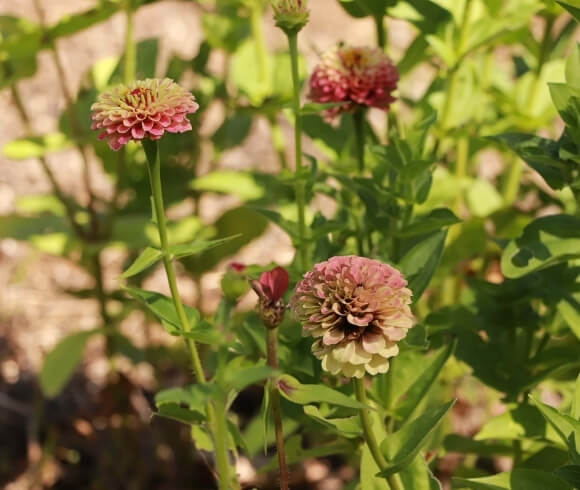
These zinnia seed are from the “Queen” line of zinnia, which I sourced through Johnny’s Selected Seeds, the above being “Queen Lime Red“. I cannot describe the flower any better than Johnny’s has.
Unusual antique color.
These 2-3½” blooms have soft burgundy outer petals that gradually lighten to creamy-lime centers. A mix of fully double, semidouble, and a small percentage of single flowers
JSS
The antique color of these blooms, which come in red, orange, and lime as well, make for the most stunning cut bouquets!
No matter which color or style you select, you cannot go wrong when adding zinnia to your garden beds.
GROWING ZINNIA BEAUTIFULLY
I have to say I have grown some very fussy plants in my time, but zinnia are not one of them.

Zinnia are known to be resistant to pests, & are at ease in most soil conditions. They do enjoy a soil pH of between 5.5 and 7.5. Water and sun are all they really need to put on a display.
ZINNIAS WATERING REQUIREMENTS
Zinnias are typical in their water needs as far as most flowers go. Plan on watering to approximately an inch a week in total. That means no matter if Mother Nature waters or you do, keep it to about an inch.
Too much water and zinnia can develop a fungi known as powdery mildew. Due to that risk, when watering avoid spraying the foliage and flower itself. Instead water from the base of the plant only, avoiding watering during the heat of the day.
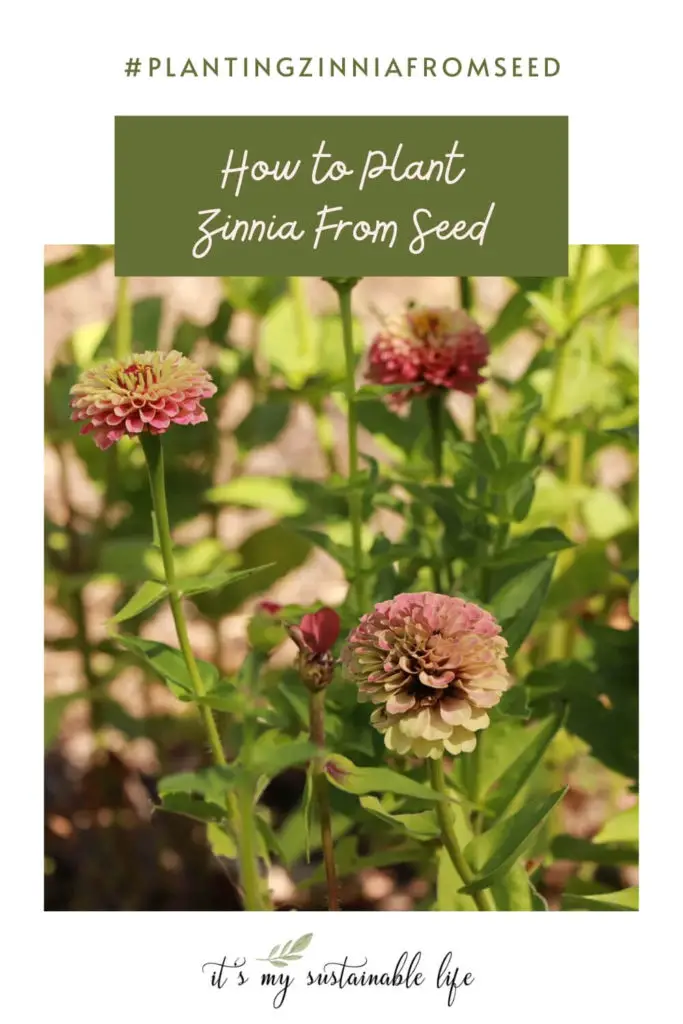
I highly recommend using a soaker hose or drip irrigation for all your watering needs in the garden. I feel these types of watering systems are a much more sustainable approach to watering our gardens as its saves water, but also reduces risk of disease and saves me boatloads of time 😊
ZINNIAS SUNLIGHT REQUIREMENTS
The biggest requirement zinnia needs to grow prolifically is sun. They require full sun conditions, meaning they need at a minimum, 6 hours of direct full sun exposure, for best results.
Although they can tolerate some shade, especially when grown in warmer climates, the risk is increased for disease development.
When choosing your location to either direct seed your zinnia or transplant them, ensuring it has good air circulation can reduce the risk of them developing that powdery mildew down the road.
ZINNIAS SPACING REQUIREMENTS
When direct seeding zinnia into the garden, plant zinnia at least 2 inches apart in rows or beds. Plan on thinning later to at least 8 to 18 inches apart once the plant has developed its “true leaves” (four leaves total on the plant).
These are rough guidelines and are certainly dependent upon which variety you have chosen to grow.
ZINNIAS PLANTING REQUIREMENTS
Sow directly into the garden in the spring once danger of frost has passed, following the above guidance or according to the directions found on your seed packet.
This typically is about the same time as you would plant your tomatoes into the ground.
For those impatient to see those beautiful zinnia blooms a bit earlier that have grown their zinnia indoors, plan on transplanting hardened off (acclimated to the outdoor conditions) zinnia once danger of frost has passed as well.
HOW LONG DOES IT TAKE TO GROW ZINNIA FROM SEED
Zinnia will take approximately between 60 to 70 days from the time you plant the seed to the time you see a bloom. Again, this is a rough estimate, as times will vary according to the variety you choose.
DO ZINNIA SEEDS NEED TO BE SOAKED BEFORE PLANTING
I feel that is up to you. I never soak my seed before planting and have found no difference in germination rates or times by not soaking.
If you do soak, plan on soaking the zinnia seeds for no more than 4-6 hours prior to planting.
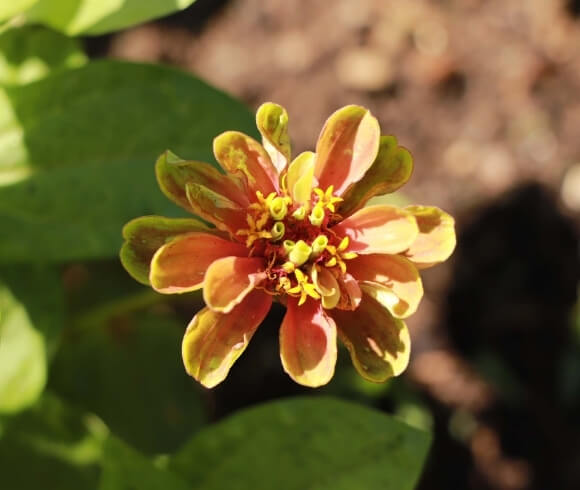
HOW TO GROW ZINNIA FROM SEED
Purchasing annuals, zinnia included, can be an expensive one. Especially with as many zinnia as I enjoy growing 😂
Thus, growing zinnia plants from seed saves you tons of mula! You have two options as I’ve stated, when learning how to grow zinnia from seed. Direct seed or start indoors.
It should be noted that many say zinnia are a bit finicky when it comes to transplanting your started zinnia as they don’t like their roots disturbed. I’ve not found that to be the case, and if you know anything about my gardening style, I’m a right or die gardener. Not the most gentle in my handling of plants.
Call it the New Englander in me, toughen up or your out 😊
And I’m not the most patient either. Therefore, I start my zinnia plants indoors and have great success doing so.
TIPS FOR STARTING ZINNIA INDOORS
If you are concerned with the transplanting process and disturbing the zinnias root system, start your seeds in biodegradable containers that can be directly planted into the garden. Peat pots, poo pots and the like would work wonderfully.
When sowing indoors, plan on sowing at least 4-6 weeks prior to your transplant date. In a container, using seed start mix that has been dampened, sow the seeds 1/4 inch deep, covering lightly with the soil mix.
Keep the soil moist and warm. I use a heat mat to keep my soil an even temperature of between 70F to 75F. Seedlings will typically take approximately 7-10 days to emerge. Once they do, provide plenty of light, either on a windowsill or using grow fluorescent plant lights turned on for about 16 hours per day.
Once the seedlings have developed two sets of leaves, thin to one plant per cell.
For a complete in-depth tutorial on seed starting be sure to stop by and check out my article on just that, Seed Starting 101.
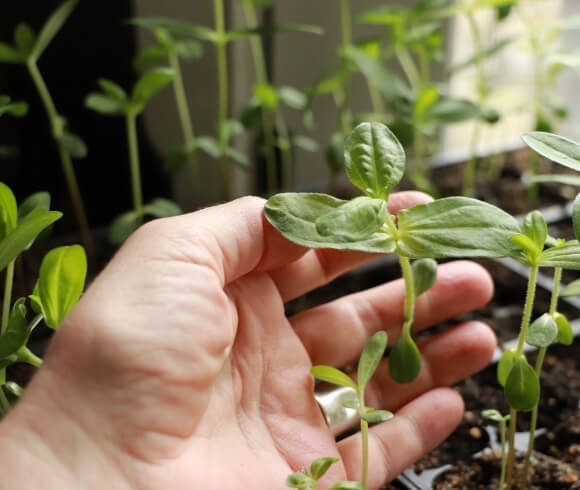
TIPS FOR DIRECT SEEDING ZINNIA INTO THE GARDEN
Once danger of all frost has passed, zinnia may be directly sown into the garden, beds, or containers.
To do so, in well prepared garden soil, sow the zinnia seed directly into the soil, about 1/4 inch deep according to the spacing requirements listed above or on your seed packet.
You will be enjoying the small green sprout of new growth in about 7 days.
TIPS FOR TRANSPLANTING PURCHASED ZINNIA PLANTS
Should all else fail and you purchase your plants from your local nursery or gardening center and the plants have reached to blooming stage, to help alleviate any shock or disturbance its wise to cut it back by 1/3.
Why? It will send some new growth energy back into the root system and also create a more beautifully full plant by encouraging bushing.
To transplant:
- Dig a whole a least twice the size of the root ball
- Place the plant in the hole so the root ball is even with the top of the soil
- Backfill the soil, tamping down slightly
- Water well to allow the soil to settle, have good root to soil connection, and release any air pockets
HOW TO CARE FOR ZINNIA
As with most plants, zinnia does not do well when weeds begin to take over. Keep your zinnia bed weed free for happy 🪴
Mulching is highly recommended to help in this department. Mulch also assists with retaining soil moisture levels & helps to maintain soil temperatures. Should you utilize mulch, it’s always wise to keep it a bit away from the stem of the plants. Let ’em breath a bit if you will. This will reduce the chances of stem rot.
Keep watered as mentioned (about 1 inch total per week). Keep a close eye on your plants during the driest portions of the season. I recommend using a rain gauge if you need help in monitoring.
Once you’ve established your plants and notice new growth, now is the time to add a bit of fertilizer. I highly recommend using liquid kelp, seaweed, or an organic 5-5-5 fertilizer.
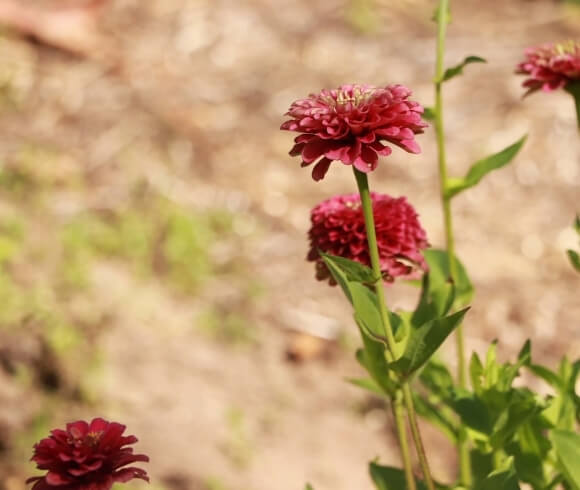
To encourage bushier plants, pinch young plants back to promote branching. That is unless it’s your goal to have long stems for cutting or need height in your garden bed 😊
Continual deadheading is necessary to promote new growth & ensure you will have continuous blooms throughout the season.
Should you want to save the seeds, allow the last flowers of the season fully mature, cut, dry, and save.
NOTE: It’s vital that you know if your zinnias are open-pollinated or hybrids. Hybrids will very rarely stay true to the parent plant. Zinnias will cross-pollinate very easily. Unless you are able to plant those that you wish to save true seed far, far away, like one plant variety per half-mile (who has that kind of space?), you should bag or cage several flower buds prior to blooming to prevent cross-pollination.
DEADHEADING ZINNIA TIPS
So where exactly do you deadhead for best results? There are just a few considerations when it comes to snipping those plants. It all depends on what your end goal is.
- HEIGHT – Where you snip your plant matters as far as height. Snip down low on the plant will result in a lower plant overall, higher up the stem, the opposite
- BRANCHING – Cutting anywhere on the stem will result in the plant branching at that point of cut
- LEAF REMOVAL – Zinnia is a very forgiving plant. Removing any unwanted leaves typically does not hinder the plant in any way
When is comes to cutting zinnia, the more you cut, the more blooms you reap 😃
ZINNIAS PEST & DISEASE ISSUES
There really are very few pests and diseases that cause harm to zinnia. Especially when care in proper soil preparation, sun exposures, fertilizing, mulching, and air circulation considerations have been met.
Occasionally, zinnia may be effected by aphids, spider mites, and whitefly during hotter spells. Should this happen, I simply spray them with a strong stream of water.
Again, when the growing criteria for zinnia have been met successfully, especially the watering criteria, very few disease issues will present themselves.
Already discussed is powdery mildew. Other considerations are leaf spot issues, both Alternaria,Cercospora, & Xanthomonas. Should any of these issues arise, treatment with fungicides is an option should you want to use them.
There you have it! Learning how to plant zinnia from seed is extremely simple, cost effective, and brightens any flowering garden area.
What are your favorite zinnias to plant?
Love, Light, & Laughter ~


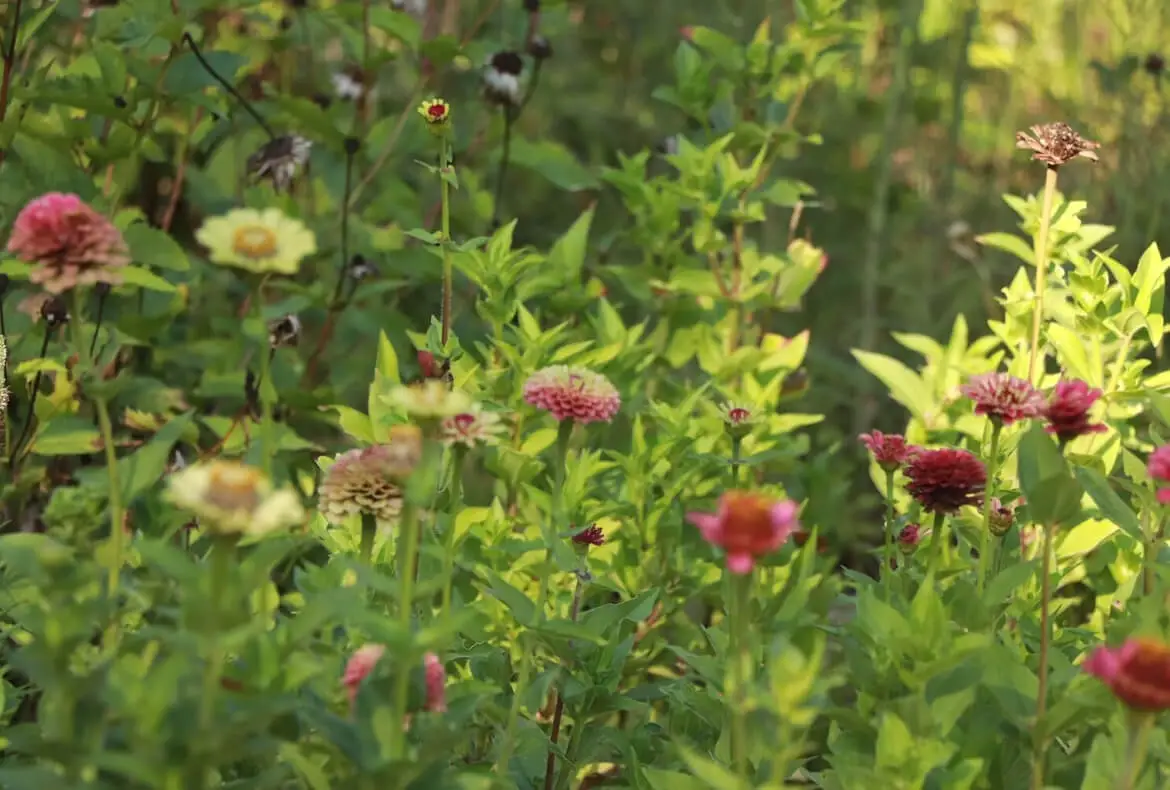
7 comments
Suzan,
Zinnias are some of my favorite flowers to grow to bring pollinators to the garden and have a choice of cut flowers for the house. A summer delight for sure!
Mine too! Beautiful AND easy to grow. What more can we gardener’s ask?
Thanks for reading, Stacie 🤗
Great post Suzan. I shall try this next time. Have a wonderful Valentines.
I’ve begun growing zinnias the past couple of years from seed and have loved it! They are such beautiful flowers and so easy to grow. I haven’t started indoors though, so maybe I need to do that this year so I can get a headstart on the blooming season. 🙂
You will definitely get your blooms faster by starting from seed indoors! Thanks so much for reading, Lisa 😊
This was a great tutorial on Zinnias.. Don’t forget when you are Dead heading the flowers to put them in a Paper bag. The flowers will dry and create seeds for the next year. Shake to bag every now and then. If you put them in a plastic bag they won’t dry and they will get moldy. This is another way to save money and you can share your seeds with your friends..
Great tip for all, Kathy! Thank you for sharing it.
S